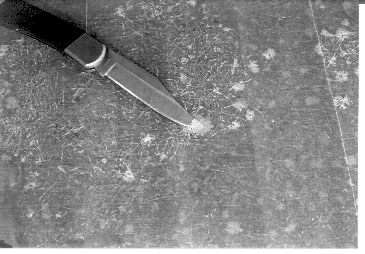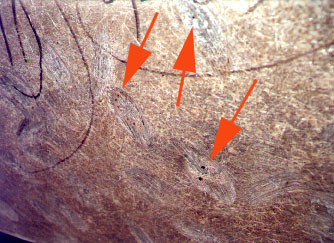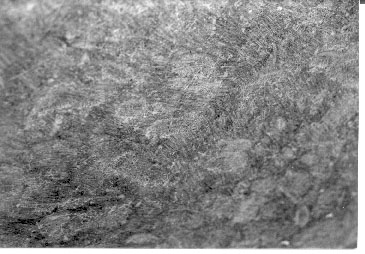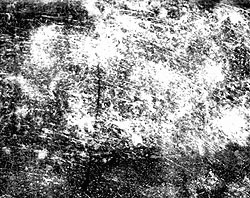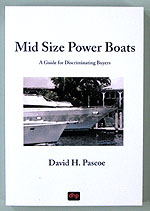|
From Article Failed
Blister Repairs
|
After removal of the newly applied barrier
coatings, this is what Mr. Williams hull looked
like. Most, if not all, of the original blister
voids remained. At right, the new resin can be seen
to have been applied directly over the old blisters.
|
| Fairing material that either turned soft or was not properly mixed and catalyzed. Although these blisters were ground away, the void spots or air bubbles within the skin out mat that initiated the blisters are clearly evident in this photo. If the voids are not removed, then the potential for reformation remains. |
| Scrape marks were made with the end of a ball point pen to indicate how soft it is , a perfect environment for blister formation. This is the point where the bottom was faired into the old gelcoat at the boot stripe. Note blister voids at lower center. |
| Comparison view of fully saturated skin out mat at left, poorly saturated mat at right also showing numerous void spots or air bubbles. Notice that no blisters appear in the fully saturated laminate. |
| This photo, not this essay's subject vessel, shows a boat bottom with at least two dozen grind spots in little more than one square foot area. Despite all the grinding, hundreds of voids and areas of unsaturated fibers remain. When the condition of the skin out mat is this bad, it cannot be successfully repaired. It must be removed completely. Unfortunately for the owner, the yard simply filled the holes and recoated it, with a high probability that the repair will fail. |
| Here is a particularly good shot of unsaturated fibers in a skin out mat. These really stand out because the layup resin in this hull is tinted dark blue. In most cases, the poorly saturated fibers do not stand out this well. In this case, as in so many others, the repairer simply applied a new barrier coat on top of this mess and the blisters reappeared with six months. |
Go to Article
Related Photos:
The Wonderful World of Hull Blistering
Avoiding the Blister Blues
First posted on Sept 2, 1997 at David Pascoe's site:
www.yachtsurvey.com.



